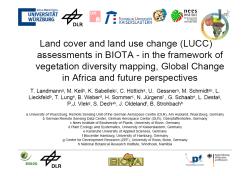|
|
|
 |
|
|
Presentation
< back to presentation overview
| Details of the presentation |
| Presentation |
Oral presentation |
| Title |
Land cover and land use change assessments in BIOTA - in the framework of vegetation diversity mapping, Global Change in Africa and future perspectives
|
| PDF Download |
 Download PDF (Filesize 8.7 MB)
Download PDF (Filesize 8.7 MB)

|
| Short title |
A synthesis of vegetation mapping and land use change monitoring possibilities in BIOTA
|
| Author(s) |
Landmann, T.(1); Keil, M.(2); Sabellek, K.(3); Hüttich, C.(1); Gessner, U.(1); Le, B.(4); Schmidt, M.(1,2); Schaab, G.(5); Lung, T. (5);Weber, B. (8); Lieckfeld, L.(2); Oldeland, J.(6); Sommer, H.(3); Wegmann, M.(1); Vlek, P.L.G.(4); Yao, N.(1); Dech, S.(1,2); Strohbach, B.(7); Jürgens, N.(6)
|
| Presenting author |
Landmann, T. (1); Keil, M. (2)
|
| Institution(s) |
(1) Remote Sensing Department in cooperation with DLR, University of Wuerzburg; (2) German Remote Sensing Data Centre (DFD), German Aerospace Centre (DLR), Oberpfaffenhofen; (3) Nees-Institute for Biodiversity of Plants, University of Bonn; (4) Center for Development Research (ZEF), University of Bonn; (5) Institute of Applied Research, Karlsruhe University of Applied Sciences; (6) Biocentre Klein Flottbek, University of Hamburg; (7) Vegetation Ecology National Botanical Research Institute, Windhoek; (8) Deptartment of Biology, Plant Ecology and Systematics, University of Kaiserslautern.
|
| Keywords |
Land cover, land use change, vegetation structure, vegetation types, global change, remote sensing, change drivers, monitoring mechanism
|
| Abstract |
Interdisciplinary assessments of land cover and land use change (LUCC) and small scale vegetation structure are imperative for improved and sustainable biodiversity management. Remote sensing is a main information source that can render spatially extended, repeatable, updatable and up-to-date land surface information related to vegetation structure and LUCC. Within BIOTA Africa, remote sensing observations with linkages to socio-economic data and plant diversity were utilized for biodiversity assessments, using LUCC scenarios for focus areas within BIOTA. Starting at a fine scale for BIOTA sites in Southern Africa, a number of satellite systems at variable scales and botanical survey data are combined to provide standardized observations of vegetation diversity. Daily acquired satellite time series provide additional information on the phenological characteristics that is vegetation fractions at broader scales. On a regional scale in West Africa, LUCC rates were rigorously observed. These remote sensing derived observations were augmented with socio-economic data, rendering information on the most relevant LUCC drivers. Population pressures, the expansion of croplands and infrastructural developments were the most important drivers for land use transformation and modifications. The expansion of croplands was also observed in the communal areas in northern Namibia and similarly in the woodlands of Kenya. We show that continental and regional LUCC scenarios combined with plant species data can be used to map future projections of biodiversity over several decades. We highlight the potential of our interdisciplinary monitoring approach for Global Change investigations in Africa and the perspectives within GEO-BON (Group on Earth Observations Biodiversity Observation Network).
|
| Congress Topic |
Observation System
|
| Topic No. |
1.1 |
| Notes |
---
|
| Ref. No. |
544 |
|
|
|
